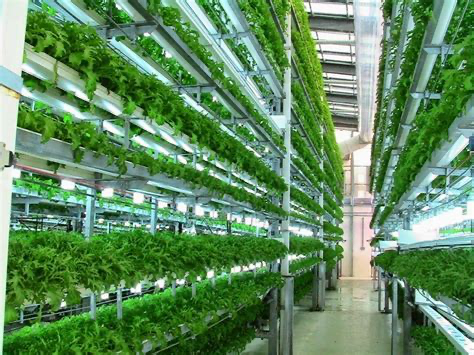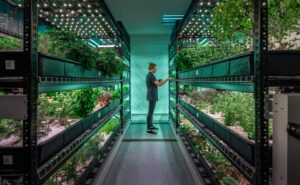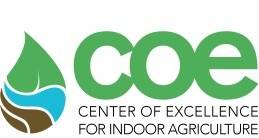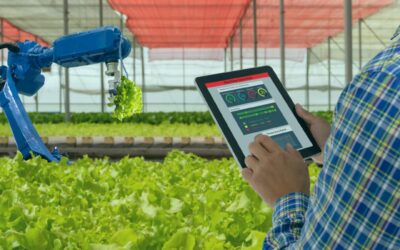Introduction
New York City (NYC) and the state of New York are becoming hot spots in the field of vertical farming. A few of its big players like Gotham Greens, Square Roots, and Farm.One have positioned themselves in this industry due to the boundless opportunities that New York’s resources and population size offer. This post will highlight the impacts these and other indoor farms are having in NYC and the rest of the Empire State.
What is Indoor Farming?
Indoor farming represents the cultivation of crops in a controlled environment thus allowing for year-round growing. This approach to growing food includes a range of methods such as greenhouse production, hydroponics, aeroponics, plant factories, and vertical farming.
Many new technologies and methods are used to fine-tune nutrient delivery, water use, climate conditions and artificial lighting to create optimal growing conditions using fewer resources. These innovative designs and technologies help make indoor farming methods more sustainable and allow for the production of fresh vegetables and greens anywhere throughout the year (Stein 2021).

Benefits of Indoor Farming
The benefits of indoor farming are numerous. Some argue that on a macro scale indoor farming addresses many of the concerns regarding traditional food production methods such as the over-use of pesticides, the consumption of freshwater, soil erosion, and nutrient loading. Furthermore, some argue that it offers a new way to feed an ever increasing world population, which is expected to climb to over 9 billion by 2050.
On a micro level, indoor and vertical farming offers sustainable growing practices, higher yields with the use of less water and space, pesticide-free fresh foods, consistent quality, stable pricing, year-round availability, and local production close to urban centers (Stein 2021). The appearance of Covid-19 has highlighted the weakness of long-distance food supply chains in the United States, pointing towards the importance of local and sustainable food sources.
Why New York?
It is well-known that New York has one of the largest state populations in the United States, currently at just over 19 million people. NYC also has the highest population density of any major city in the U.S, housing over 27,000 residents every square mile—a number that continues to increase. While outside of dairy industry, the state is not well-known for the production of vegetables. New York is now beginning to exploit the possibilities of vertical farming to sustain its many inhabitants.
In New York City, there is hardly enough room for all its office buildings, restaurants, shops, and apartments, let alone a conventional farm. Because the land in this bustling city is so precious, much of its produce must be either obtained through costly means or outsourced from other areas—many of which are hundreds or thousands of miles away. There is also the issue of energy consumption and increased environmental impact of agriculture. Transporting this produce by truck or plane burns fossil fuels and produces significant amounts of CO2. Companies like Gotham Greens and Farm.One hope to mitigate some of these challenges through increased convenience and efficiency of crop production along with other goals such as providing employment and increasing the productivity of limited real estate in urban areas.
Gotham Greens // Brooklyn, New York
Headquartered in Brooklyn, New York, Gotham Greens has grown to be one of the largest and most influential indoor farms in NYC and environs. Beginning with just one greenhouse on a rooftop in Brooklyn, co-founders Viraj Puri and Eric Haley are developing farms across the country; e.g., setting up in other major cities like Chicago, Baltimore, Providence, and Denver. The company’s efforts are geared toward customer and community satisfaction, and Gotham Greens has a product line that encompasses popular greens including various types of lettuce, herbs, pre-made salad bowls, and even salad dressings.
According to its web site, Gotham Greens’ mission is to decrease the time from harvest to consumption, thus preserving the quality of the produce while feeding more people faster. With its technology and business model, consumers can enjoy fresh, high-quality produce year-round. They also emphasize sustainability, claiming to use 95% less water and 97% less land for yields compared with traditional farms. Other sustainable practices include investing in renewable energy sources such as wind and solar power as well as implementing cutting-edge technology to support climate-control.
Gotham Greens is looking to expand further, eventually moving further west into California and other states. They are rapidly growing, continuing to improve their technology and infrastructure to produce high quality, local produce for a broad range of customers nationwide. They recently received a cash infusion of $87 million to put them at a total of $130 million (AgFunder Network Partners, 2020).

Source: https://www.gothamgreens.com/
Farm.One // Manhattan, New York
Farm.One, located in Manhattan, New York, takes a smaller-scale quality-focused approach to indoor crop production. They specialize in delicacies such as rare herbs, edible flowers, and microgreens, catering to Michelin-starred restaurants and upscale supermarkets in addition to individual consumers. The goal is to create a high quality product that is attractive to chefs and consumers alike. As stated by CEO Robert Laing on their website, “We scour the globe for rare seeds, and built a vertical farm with the very best technology to provide an edible experience unlike anything before.” (Farm.One, 2020).
Another way Farm.One increases efficiency of production and product quality is through its customized lighting systems, which are supplied by Fluence (OSRAM). This lighting system was built specifically to support a diverse range of plants in very close proximity. Able to adjust to fit the needs of each individual crop, it allows Farm.One to cultivate anything from microgreens to leafy greens. Further, unlike other indoor farms, Farm.One operates in several small scale areas. One of its farms, dubbed the Mini Farm, sits at a 3-tiered, 36 square foot area. This small footprint allows for a simpler management of crop health and a quicker harvest. The company claims the small-scale helps to preserve the product freshness and quality for customers while maintaining sustainable practices.
Looking forward, Farm.One plans to target other up-scale supermarkets and restaurants. They have already launched a small vertical farm in a Manhattan Whole Foods store and are looking to expand further.

Source: https://Farm.One
Other Indoor Farms in NYC
Square Roots, located in Brooklyn, New York, is a high-tech, growing vertical farm. Founded by Kimball Musk, their goal is to modernize the food system to make produce accessible year-round for generations. They use a container system of indoor farming, designing their Super Farm to be a network of independent, climate-controlled containers. This system allows for ease of scale, crop diversity, and optimization by location (Musk 2019). They emphasize the importance of creating experiences for the younger generations, focusing on being able to work in tandem with technology.
Oishii Farms is a smaller-scale hydroponic farm focusing its attention on growing high-quality strawberries. Their seeds come from Japan, and they strive to produce ripe, juicy berries year-round. They claim to emphasize quality above any other factor, selling only fruit in its finest form. While the actual location of their farm is unclear (it is not indicated on the web site), Oishii Farms delivers mainly to the NYC area including the Upper West and Upper East Sides, Midtown, and Lower Manhattan.
Verticulture is an aquaponic farm in Flushing, New York which primarily produces basil for local retailers. They raise Tilapia fish, currently housing about 150 of them to be used for plant nutrients. A six-year-old company, Verticulture is selling its produce to restaurants and markets in the New York metro area. Their stated mission to produce food in an sustainable and efficient manner, using the fish to produce nutrients for the plants and the plants to filtrate water for the fish. In the future, the company is looking to to further develop its aquaponic practices to become more economically viable.
Rikers Island Greenhouse is a nonprofit organization that offers greenhouse training and therapy to the Rikers Island jail complex inmates. Inmates are able to learn gardening skills, care for plants, and foster a greater appreciation for their food. They have a large emphasis on building community support and development, all the while producing an abundance of organic produce.
Summary
Already a leader in many business aspects such as financial services and retail trade, New York has recently embraced the indoor farming movement. This industry allows them to produce and deliver fresh food to feed a rapidly growing population on limited land. While most of the larger indoor farms focus on mass quality production for restaurants, supermarkets, and individual consumers, several of the smaller ones emphasize community and education. We look forward to seeing the progress of these evolving indoor vertical farms in NYC and vicinity.
References
1. AgFunder Network Partners. (2020). Gotham Greens raises $87m Series D funding to decentralize food production. https://agfundernews.com/gotham-greens-raises-87m-series-d-funding-to-decentralize-food-production.html
2. Farm.One. (2020). farm.one. https://farm.one/
3. Investopedia. (2019). New York’s Economy: The 6 Industries Driving GDP Growth. https://www.investopedia.com/articles/investing/011516/new-yorks-economy-6-industries-driving-gdp-growth.asp
4. NYC Department of City Planning. (2015, July). Population – New York City Population. https://www1.nyc.gov/site/planning/planning-level/nyc-population/population-facts.page.
5. Square Roots. (2019). 10 Ways Container Farms Empower Next Gen Farmers. https://squarerootsgrow.com/2019/04/15/10-Ways-Container-Farms-Empower-Next-Gen-Farmers.html
6. Stein, E. W., (2021). The Transformative Environmental Effects Large-Scale Indoor Farming May Have On Air, Water, and Soil. Air, Soil and Water Research. January 2021. doi:10.1177/1178622121995819
7. World Population Review. (2021). New York Population 2021. https://worldpopulationreview.com/states/new-york-population
Contributors
Eric W. Stein, Ph.D. and Victoria Mock were contributors to this post.




